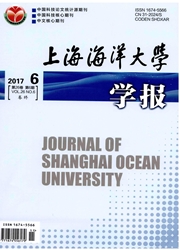

 中文摘要:
中文摘要:
为建立有效的坛紫菜自由丝状体移植育苗技术,以坛紫菜的2个选育品系"申福1号"和"申福2号"及野生型品系为实验对象,初步研究了自由丝状体的移植量、移植后培养的光密度和温度对贝壳丝状体的生长和壳孢子放散量的影响,结果如下:当自由丝状体移植量为50~500 mg/m2,随着移植量的增加,贝壳丝状体的藻落数显著增加,但移植量如果超过100 mg/m2,贝壳丝状体的壳孢子放散量反而减少。培养光密度在10~50μmol photons/(m2.s)范围内,随着光密度的增加,贝壳丝状体的生长速度明显增快,但壳孢子的放散量却随着光密度的提高而减少。培养温度在15~25℃范围内,随着温度的升高,贝壳丝状体的生长明显加快;在15~20℃范围内,壳孢子放散量随着培养温度的升高而增加,在20~25℃范围内,壳孢子放散量反而随着培养温度的升高而减少。上述结果表明,在坛紫菜自由丝状体移植育苗中,过大的丝状体移植量、过高的培养温度和光密度均会导致贝壳丝状体的壳孢子放散量减少。
 英文摘要:
英文摘要:
By using three strains(two improved strains(SF-1 and SF-2) and the wild type(WT)) of free-living conchocelis of Prophyra haitanensis,the optimal transplanting quantity and the influence of the initial density of conchocelis colony,photon flux density and temperature for vegetative growth of conchocelis and the conchospore number of conchocelis were studied.The results indicated that the initial density of conchocelis colony significantly increased with the increase of transplanting quantity in range of 50-500 mg/m2.However,when the tansplanting quantity was higher than 100 mg/m2,the conchospore number decreased.Increase of photon flux density within the range of 10-50 μmol photons/(m2·s)accelerated the vegetative growth of conchocelis,but decreased the conchospore number.Increasing temperature within the range of 15-25 ℃ accelerated the vegetative growth of conchocelis.However,the conchospore number increased with the increase of temperature from 15 to 20 ℃,and decreased with the increase of temperature from 20 to 25 ℃.The vegetative growth and conchospore number of SF-1,SF-2 and WT strains showed no significant differences.The above results indicated that higher transplanting quantity,photon flux density and temperature in culture of conchocelis will reduce the conchospore number of conchocelis when seeding with free-living conchocelis in P.haitanensis.
 同期刊论文项目
同期刊论文项目
 同项目期刊论文
同项目期刊论文
 期刊信息
期刊信息
